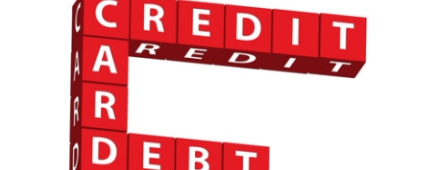U.S. Credit Card Debt Set To Reach Pre-Recession Levels

U.S. consumers racked up credit-card debt in Q2 twice as fast as at any time since the recession — and credit-card charge-off rates appear to be headed up too, according to new data from the Federal Reserve and FDIC included in a report by CardHub.
That puts U.S. credit-card debt on track for its biggest gain since the recession, and means consumers are predicted to end the year with $54.8 billion more in credit-card debt than they started with, or almost $900 billion. Consumers are also expected to default on $30.35 billion in credit-card debt in 2014, CardHub analysts said.
The big Q2 run-up follows a big pay-down that has become a regular pattern for the past few years. Since 2011, consumers have spent every Q1 paying down card debt after a big spending binge in the preceding Q4, then returning to their debt-generating ways for the rest of the year.
That’s been the case in 2014, too — but while Q1-to-Q2 credit-card debt rose 1.08 percent in 2011, 1.2 percent in 2012 and 1.23 percent in 2013, it jumped by 2.62 percent in the second quarter of 2014.
And while credit-card charge-offs have been falling steadily for the past four years after peaking at almost 11 percent in 2010, the charge-off rate for Q2 was 3.45 percent — not high, but up from a low of 3.19 percent in Q3 2013.
Average U.S. household credit debt rose during Q2 by $174 to $6,802, and CardHub projects that will pass the $7,000 mark before the end of the year — a level credit-card debt hasn’t seen since 2010. “Assuming the above projection holds true, by the end of 2014 U.S. consumers will be roughly $1,300 away from from the credit-card debt tipping point, where minimum payments become unsustainable and delinquencies skyrocket,” the CardHub report says.
How solid that risk is remains unclear. CardHub’s report includes its analysis, which is based on Federal Reserve and FDIC data from shortly after the end of Q2. But the report also includes the freshest available data from the Fed and FDIC, which in some cases have been adjusted so that they no longer match the data that CardHub based its projections on.
For example, based on early data, CardHub reported that U.S. consumers paid down $32.5 billion in Q1, but wiped out most of that by adding $25.5 billion in debt during Q2. Under the revised numbers from the Fed and FDIC, consumers paid down $39.2 billion in Q1 and then ran up $21 billion in Q2, only slightly more than half of the Q1 paydown.
However, the revised numbers for charge-off rates still match CardHub’s analysis, showing that bad credit-card debt has been rising steadily since mid-2013.
